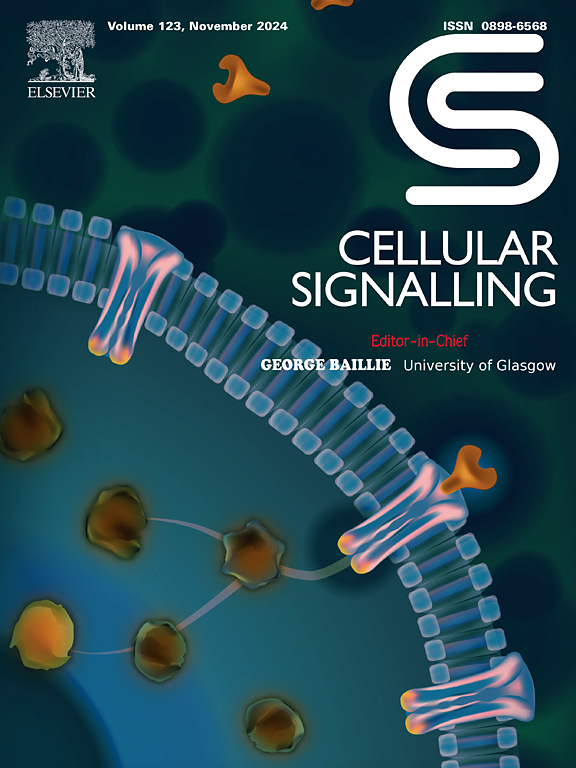toll样受体2的激活促进了人多囊肾病细胞炎症介质的表达和细胞增殖。
IF 4.4
2区 生物学
Q2 CELL BIOLOGY
引用次数: 0
摘要
常染色体显性多囊肾病(ADPKD)的特点是充满液体的囊肿进行性扩大,导致肾功能下降。toll样受体(TLR)-2和TLR4是模式识别受体和先天免疫反应的组成部分。我们发现,在ADPKD患者和PKD小鼠的肾脏中,TLR2和TLR4、一个接头蛋白MyD88和转录因子NF-κB的mRNA水平升高。与正常人肾脏相比,ADPKD肾细胞质中分离NF-κB的抑制蛋白i - b α表达降低,NF-κB核易位增加(NHK)。Pam3CSK4是一种合成的TLR2激动剂,在培养的人ADPKD细胞中增加i -κB α的磷酸化,降低其总水平,引起NF-κB核易位和促炎介质的上调。Pam3CSK4还增加了磷酸化的ERK(一种丝裂原激活的蛋白激酶)和磷酸化的S6 (mTOR途径的下游靶点),并加速了ADPKD细胞的增殖。相比之下,Pam3CSK4不影响NHK细胞的NF-κB或ERK,而是诱导细胞毒性,提示TLR2激活的作用仅针对ADPKD细胞。TLR4激动剂治疗不影响ADPKD或NHK细胞中的NF-κB或ERK信号传导。抑制TGF-β-活化激酶-1 (TAK1)可有效抑制pam3csk4诱导的NF-κB和ERK活化及ADPKD细胞的增殖。这些发现表明,在ADPKD细胞中,TLR2的激活通过TAK1增加NF-κ b介导的炎症介质和erk依赖性细胞增殖。我们认为TLR2/TAK1轴是减少ADPKD炎症和囊肿生长的潜在治疗靶点。本文章由计算机程序翻译,如有差异,请以英文原文为准。

Activation of toll-like receptor 2 promotes the expression of inflammatory mediators and cell proliferation of human polycystic kidney disease cells
Autosomal dominant polycystic kidney disease (ADPKD) is characterized by the progressive enlargement of fluid-filled cysts, leading to a decline in renal function. Toll-like receptors (TLR)-2 and TLR4 are pattern recognition receptors and components of the innate immune response. We found that mRNA levels for TLR2 and TLR4, an adaptor protein MyD88, and the transcription factor NF-κB were elevated in the kidneys of ADPKD patients and PKD mice. There was decreased expression of IκBα, an inhibitory protein sequestering NF-κB in the cytosol, and increased NF-κB nuclear translocation in human ADPKD kidneys compared with normal human kidneys (NHK). Pam3CSK4, a synthetic TLR2 agonist, increased the phosphorylation of IκBα, decreased its total levels, and caused NF-κB nuclear translocation and upregulation of pro-inflammatory mediators in cultured human ADPKD cells. Pam3CSK4 also increased phosphorylated ERK, a mitogen-activated protein kinase, and phosphorylated S6, a downstream target of the mTOR pathway, and accelerated ADPKD cell proliferation. By contrast, Pam3CSK4 did not affect NF-κB or ERK in NHK cells, but rather induced cytotoxicity, suggesting that TLR2 activation's effect was specific to ADPKD cells. Treatment with a TLR4 agonist did not affect NF-κB or ERK signaling in either ADPKD or NHK cells. Inhibition of TGF-β-activated kinase-1 (TAK1) effectively suppressed Pam3CSK4-induced NF-κB and ERK activation and the proliferation of ADPKD cells. These findings suggest that activation of TLR2 increases NF-κB-mediated-inflammatory mediators and ERK-dependent cell proliferation through TAK1 in ADPKD cells. We propose that the TLR2/TAK1 axis is a potential therapeutic target to reduce inflammation and cyst growth in ADPKD.
求助全文
通过发布文献求助,成功后即可免费获取论文全文。
去求助
来源期刊

Cellular signalling
生物-细胞生物学
CiteScore
8.40
自引率
0.00%
发文量
250
审稿时长
27 days
期刊介绍:
Cellular Signalling publishes original research describing fundamental and clinical findings on the mechanisms, actions and structural components of cellular signalling systems in vitro and in vivo.
Cellular Signalling aims at full length research papers defining signalling systems ranging from microorganisms to cells, tissues and higher organisms.
 求助内容:
求助内容: 应助结果提醒方式:
应助结果提醒方式:


